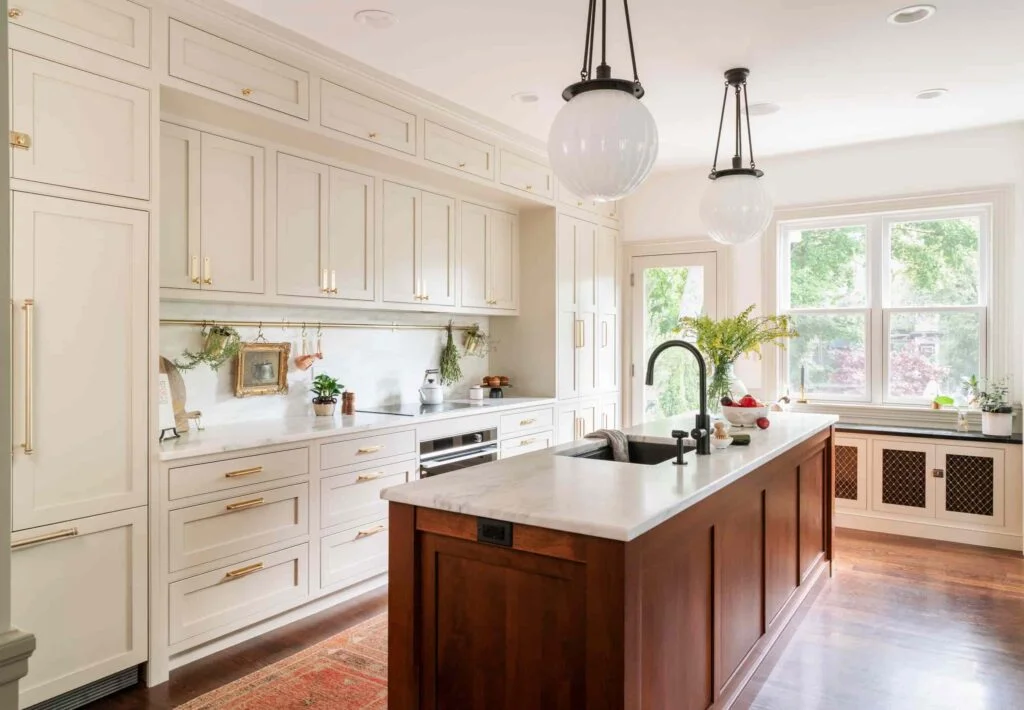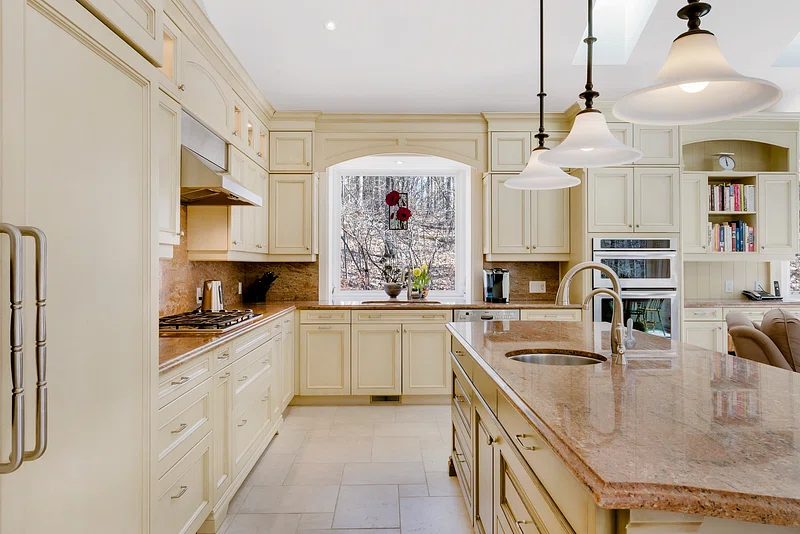kitchen layout ideas with island
Introduction:
kitchen layout ideas with island The kitchen is the heart of the home, a place where culinary magic happens and memories are made. Among the various elements that define a kitchen’s functionality and aesthetic appeal, the kitchen island stands out as a versatile and stylish feature. From enhancing workflow to providing additional storage and seating, incorporating an island into your kitchen layout can transform the space into a hub of efficiency and elegance. In this article, we’ll explore unique kitchen layout ideas with islands that will inspire you to reimagine your culinary haven.

The Circular Oasis – kitchen layout ideas with island
Break away from the conventional rectangular island design and opt for a circular oasis in the center of your kitchen. A circular island not only adds visual interest but also encourages better flow and conversation among family and guests. This layout is particularly well-suited for spacious kitchens, allowing ample room for maneuvering around the island while maintaining a sense of intimacy.
Dual-Purpose Delight:
Maximize the functionality of your kitchen island by integrating it with a secondary feature, such as a built-in cooktop or sink. This dual-purpose design not only optimizes space but also streamlines your culinary workflow. Imagine effortlessly preparing ingredients on the spacious countertop while keeping an eye on simmering pots or washing dishes without missing out on the conversation. Kitchen design ideas for small spaces.
Tiered Terrain:
Elevate your kitchen island design with a tiered terrain that combines different levels for various activities. Create a raised platform for casual dining or bar-style seating, while keeping the lower level dedicated to food preparation and cooking. This multi-tiered layout adds depth and dimension to your kitchen while accommodating diverse functions within a single space.
Rustic Retreat – kitchen layout ideas with island
Infuse your kitchen with warmth and character by opting for a rustic island design crafted from reclaimed wood or distressed materials. Embrace the natural imperfections and weathered textures that evoke a sense of history and authenticity. Complement the rustic charm with wrought iron fixtures, vintage-inspired lighting, and earthy accents to create a cozy retreat that exudes timeless appeal.
Floating Finesse:
For smaller kitchens or open floor plans, consider a floating island design that visually delineates the cooking area without overwhelming the space. Opt for a sleek, minimalist island with clean lines and a slim profile to create a sense of airiness and openness. Choose lightweight materials like stainless steel or tempered glass to enhance the illusion of floating, while maximizing functionality with integrated storage and seating options.
Statement Piece:
Transform your kitchen island into a captivating focal point with a bold design that reflects your personal style and aesthetic preferences. Experiment with vibrant colors, intricate patterns, or unconventional shapes to make a statement that commands attention. Whether it’s a striking marble countertop, geometric tile mosaic, or sculptural base, let your imagination run wild and unleash your creativity to elevate your kitchen to new heights of design excellence.
Conclusion – kitchen layout ideas with island
From circular oases to rustic retreats, these unique kitchen layout ideas with islands offer endless possibilities for creating a culinary space that is both functional and fabulous. Whether you’re a gourmet chef or a weekend warrior, your kitchen island can become the centerpiece of your home, where culinary creativity flourishes and cherished memories are made. So why wait? Embrace the art of kitchen design and embark on a journey to transform your culinary haven into a masterpiece of style and sophistication.
1.Reduce Traffic for your kitchen layouts:
Introduction – kitchen layout ideas with island
In a bustling household, the kitchen is often the epicenter of activity, where meals are prepared, conversations flow, and memories are created. However, a busy kitchen can quickly become congested, leading to frustration and inefficiency. To create a harmonious culinary haven, it’s essential to implement strategies that reduce traffic and optimize the flow of movement. In this article, we’ll explore unique approaches to streamline your kitchen layouts, ensuring smooth navigation and enhancing the overall functionality of the space.
Embrace the Galley Concept:
Emulate the efficiency of a ship’s galley by adopting a galley-style kitchen layout. This design features parallel counters and workstations along a central corridor, minimizing unnecessary foot traffic and maximizing workspace. By strategically placing appliances, storage, and prep areas along the two walls, you can create a seamless workflow that allows multiple cooks to collaborate without getting in each other’s way.
Create Dedicated Zones:
Divide your kitchen into distinct zones based on specific tasks, such as food preparation, cooking, and cleanup. By allocating separate areas for each activity, you can minimize congestion and prevent cross-traffic that disrupts the flow. Designate ample counter space near the refrigerator for unpacking groceries, establish a dedicated cooking zone with easy access to the stove and oven, and reserve a separate area for washing dishes and cleanup to maintain order and efficiency.
Implement an Island Oasis:
Integrate a well-designed kitchen island into your layout to serve as a central hub for cooking, dining, and socializing. A strategically positioned island can act as a barrier to direct traffic away from high-traffic areas, such as the cooking zone and the sink. Opt for a streamlined design with built-in storage and seating options to maximize functionality while minimizing clutter. Additionally, consider incorporating a traffic-free zone around the island to ensure unobstructed movement and easy access to essential amenities.
Optimize Traffic Patterns – kitchen layout ideas with island
Analyze the natural flow of movement within your kitchen and reconfigure the layout to minimize congestion hotspots. Arrange key elements, such as appliances, cabinets, and workstations, in a logical sequence that facilitates efficient navigation. Ensure that pathways are wide enough to accommodate multiple users simultaneously and eliminate any obstacles that impede the flow of traffic. By optimizing traffic patterns, you can create a more ergonomic and user-friendly kitchen environment that enhances productivity and comfort.

Conceal Clutter with Smart Storage Solutions:
Combat clutter and chaos by incorporating smart storage solutions that keep countertops clear and organized. Invest in spacious cabinets, drawers, and pantry systems to stow away cookware, utensils, and ingredients out of sight. Utilize vertical space with wall-mounted shelves and racks to store frequently used items within easy reach. By concealing clutter and maximizing storage capacity, you can create a streamlined kitchen layout that promotes a sense of calm and order.
Conclusion:
By embracing these unique strategies to reduce traffic in your kitchen layouts, you can transform your culinary space into a haven of efficiency and tranquility. Whether you opt for a galley-style design, create dedicated zones, implement an island oasis, optimize traffic patterns, or invest in smart storage solutions, the key is to prioritize functionality and flow. With careful planning and thoughtful execution, you can create a kitchen that not only looks beautiful but also functions seamlessly, allowing you to enjoy the art of cooking without the hassle of navigating through traffic jams.
2.Make the Distance between Main Fixtures Comfortable:
Designing Your Kitchen – kitchen layout ideas with island
Ensuring Comfortable Distances Between Main Fixtures. When planning your kitchen layout, ensuring comfortable distances between main fixtures is crucial for creating a functional and ergonomic space. Whether you’re cooking, washing dishes, or gathering with family and friends, the layout should promote ease of movement and accessibility.
Start by considering the “kitchen work triangle,”
which consists of the stove, sink, and refrigerator—the three most frequently used areas. Ideally, the total distance traveled between these fixtures should be between 12 to 26 feet, with no single leg of the triangle shorter than 4 feet or longer than 9 feet. This optimal configuration minimizes unnecessary steps and maximizes efficiency during food preparation and cleanup.
3.Make Sure the Kitchen Island Isn’t Too Close or too Far:
Finding the Sweet Spot:
Perfecting the Placement of Your Kitchen Island. When designing your kitchen layout, striking the right balance with the placement of your island is essential. Avoid placing it too close to other fixtures, which can impede movement and create a cramped feel. Likewise, don’t position it too far away, causing inconvenience during meal preparation. Aim for a distance of approximately 3 to 4 feet between the island and surrounding countertops or walls, ensuring ample space for navigation and workflow. By finding the sweet spot for your kitchen island, you can create a harmonious and functional culinary space that facilitates both cooking and socializing.
4.Place the Sink First for your kitchen – kitchen layout ideas with island
When planning your kitchen layout, start with the sink. Positioning the sink first establishes the kitchen’s functional core, guiding the placement of other fixtures around it. Optimal sink placement ensures efficient workflow and convenient access to water for meal prep and cleanup. Consider proximity to windows for natural light and views while maintaining ease of access to other work areas. By prioritizing the sink in your kitchen design, you lay the foundation for a space that seamlessly combines practicality with aesthetic appeal, enhancing both functionality and comfort in your culinary haven.
5.Always Put the Stove on an Exterior Wall – kitchen layout ideas with island
When designing your kitchen layout, one fundamental principal reigns supreme: always place the stove on an exterior wall. This strategic placement not only enhances safety but also optimizes ventilation and efficiency.
By positioning the stove on an exterior wall,
you minimize the risk of fire hazards associated with heat buildup in enclosed spaces. Direct access to an exterior wall allows for efficient venting of cooking odors, smoke, and grease, keeping the kitchen fresh and comfortable.

Furthermore, placing the stove on an exterior wall facilitates convenient access to outdoor ventilation options, such as range hoods or exhaust fans. This ensures effective removal of airborne pollutants, moisture, and excess heat, creating a healthier indoor environment.
From a practical standpoint,
installing the stove on an exterior wall simplifies the installation of gas or electric connections, reducing costs and complexity. Additionally, it allows for easier maintenance and repairs, as technicians can access exterior venting systems without disturbing interior walls or cabinetry.
In conclusion – kitchen layout ideas with island
when it comes to kitchen design, always prioritize safety, functionality, and efficiency by placing the stove on an exterior wall. This simple yet essential decision can significantly enhance the performance and enjoyment of your culinary space, ensuring a seamless cooking experience for years to come. Click here for more information.